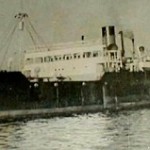In 1946, as prosecutors prepared for the war crimes trials at Nuremberg following World War II, they discovered discrepancies in the war diary (logbook) of U-30, the German submarine whose combat patrol zone was closest to the location where the British passenger ship Athenia had been torpedoed on the first day of the war. The first two pages were a different quality paper than the rest of the book. On these pages, the months were recorded in Arabic numerals, while Roman numerals were used for the months in the rest of the book. Also, the signature of the boat’s commander, Oberleutnant Fritz-Julius Lemp, was an obvious forgery. The new pages showed U-30 nearly 100 miles from the spot where Athenia was attacked on Sept. 3, 1939. The alteration was part of an elaborate, if clumsy, subterfuge started within 24 hours of Athenia’s sinking to convince the world that Germany wasn’t at fault.
Lemp did not report his attack after discovering he had torpedoed an unarmed passenger ship. As a result, the German government did not find out about the sinking until the following morning, Sept. 4, through foreign broadcasts. Government officials immediately checked with the top naval authorities and received assurances that no German naval units had been in the vicinity of the incident. The assurances were based on the fact that no warship had reported any such attack, which was superficially correct but misleading. Some ships had not reported at all, including U-30.
The Nazis were eager to deny responsibility for the sinking, because it gave England a major propaganda tool to use against Germany. Far worse, however, was the possibility that the attack on Athenia had killed Americans, which could bring the United States into the war. Germany’s Secretary of State for Foreign Affairs wasted no time that morning of Sept. 4, 1939, in offering Americans an official German denial of any responsibility for sinking Athenia. As if to assure world opinion that Germany was abiding by international treaties, Chancellor Adolf Hitler issued an order to all naval units that same day, warning that no passenger ships were to be attacked, even if they were traveling as part of a convoy.
By Sept. 5, Athenia survivors disembarking in Galway and Glasgow made it clear they thought their ship had been torpedoed and several said they had seen the submarine. By then, the German press was reporting that Athenia may have been mistakenly attacked by a British warship or had struck a floating mine. Over the next few days, the Nazis offered more possibilities for Athenia’s demise, including an exploding boiler, a bomb, or even a torpedo from a British submarine. Encouraged by the Nazi’s chief propagandist, Joseph Goebbels, the German press finally settled on the explanation that Britain’s new First Lord of the Admiralty, Winston Churchill, had planted a bomb on board Athenia in order to sink the ship, kill American passengers, and bring the United States into the war against Germany.
The story was subsequently embellished by other “facts.” Reports claimed that shipping agents were told not to book German citizens on board for fear they would witness Churchill’s ruse; that several rescue ships “mysteriously” appeared in the area even though Athenia never sent a distress signal; and that the ship was ultimately sunk by gunfire from British destroyers so that no evidence of Mr. Churchill’s scheme would survive. The only claim that remotely approached reality was the fact that bookings of new passengers had been halted at a certain point in order to hold open space for passengers transferred from other sailings that had been cancelled. Britain vehemently denied the allegations and few outside of Germany believed the Nazi assertions. Even so, the United States, which announced it would remain neutral, refrained from blaming Germany in the absence of irrefutable proof, a sign of the isolationists’ political strength in the U.S.
The Churchill story had been circulating for more than two weeks when Lemp returned to his base in Wilhelmshaven and reported to Kommodore Karl Dӧnitz that he had been responsible for sinking Athenia. Dӧnitz was extremely unhappy with his young commander, though he accepted Lemp’s explanation that he believed he had attacked an armed merchant ship. Nevertheless, he sent Lemp to Berlin to meet with the naval high command to explain what he had done and face the consequences.
The next day, a chagrined Lemp told his story to the navy’s top brass in Berlin. Not long after that meeting, Dӧnitz received word from his superiors that the entire affair was to be kept secret and that a court-martial proceeding against Lemp would not be appropriate. At Hitler’s direction, German officials continued to deny responsibility for Athenia’s sinking through the remainder of the war, and for a brief period in October, 1939, their claims of innocence received a boost from an Athenia passenger, which is the subject of our next blog.
At the end of the war, a sailor who had been aboard U-30 on Sept. 3 and who no longer felt bound by his oath of silence, swore that he had seen Athenia sinking after the U-boat’s attack. Presented at the Nuremberg trials with the sailor’s testimony and U-30’s obviously forged logbook, Karl Dӧnitz finally confirmed U-30 had sunk Athenia on the first day of the war.




